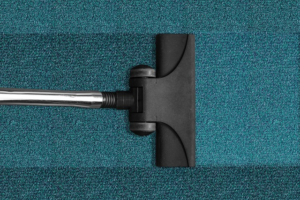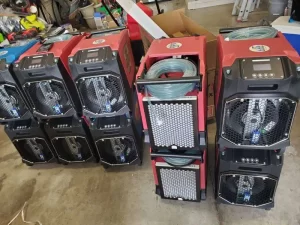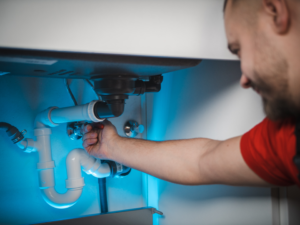One of the more unfortunate consequences of water damage is that moisture often seeps into the walls, causing wood rot, mold growth, unhealthy air, and unpleasant odors.
After repairing the source of the water damage, use this guide on how to dry walls to preserve the overall health and structural integrity of your home.
How To Dry Wet Walls After Water Damage: A DIY Guide
Use this step-by-step guide to dry and repair wet walls:
Contact a Professional
One of the best things you can do after suffering water damage that affects the walls is to contact a professional. Fast remediation is necessary, or your walls risk growing mildew and mold. Moisture that sits behind the paper backing can easily spread to nearby walls.
Depending on the cause of the wet walls, you may also be able to file an insurance claim for remediation efforts. Work with your water damage restoration company to document the wall damage and file your claim. When water is left, it can also damage the structural integrity of your wall, eventually posing a safety risk to you and your family.
Collect the Necessary Materials To Repair the Wall
Collecting the necessary materials for removing and replacing damaged drywall can make the project easier. A few tools you made need include a screwdriver, drill, hammer, scissors, screws, knife, and a hammer. Of course, you’ll also need ample drywall pieces and adhesive.
You’ll also need a few items to minimize moisture and begin drying out the walls. This includes fans, a dehumidifier, and old towels. This is also a good time to remove all your personal belongings from the area. Determine which items must be thrown out and which can be sanitized and cleaned. Your water restoration company can also assist with cleaning, sanitizing, and salvaging your personal items.
Proper remediation requires ample air, so large commercial-grade fans can be useful. Avoid using the air conditioning unit until you’re sure there isn’t any mold growth.
Dry the Walls and Floor
Sometimes, a wet wall can be dried using old towels and dry air. You can also use a dehumidifier to remove moisture from the room and help dry out the wall. If possible, open windows in the room to dry up some of the moisture. Promote air flow using fans. Ample air can reduce moisture and humidity levels and help avoid mold.
You may need to use a sump pump to remove all water from the floor. In some cases, you may also need to take the doors off the track and replace them, especially if they’re made with wood materials.
You will also likely need to drain excess water from the walls. You can do this by drilling a small hole between the studs. Continue moving up two inches and drilling holes until no more water drains. This can help you determine how far up the wall the water damage is. Try to keep the holes to a minimum of five centimeters or less. Smaller holes will make it easier to repair them when making repairs.
Once you know where to begin, start from the top and move downwards when cleaning the walls. It’s important to remember that walls don’t always show signs of water damage. Just because you can’t see the water on the wall doesn’t necessarily mean it’s not there. The best way to ensure your walls are thoroughly dry is to outsource the task to a professional.
Remove and Replace Damaged Dry Wall
Installing drywall is typically DIY friendly. However, before installing a new wall, you’ll want to remove all damaged parts. You must get all affected pieces of the wall to avoid trapped moisture. Make sure you also remove all wet insulation in the walls.
Before replacing the wall, assess if there is any damage to the wood braces. Depending on how long the water has been sitting, you may need to replace the wall beams and braces to avoid structural damage.
Secure the drywall to the outside and inside corners while installing it. Carefully measure and cut openings for the doors, windows, and outlet boxes. You can use drywall nails to adhere the sheets to the wall. Use a chalk line to mark the stud positions.
If your wall has wallpaper, it must be removed before attempting to dry. Wallpaper acts as a seal and traps moisture inside the walls. You’ll also want to remove all water-soaked molding, doors, baseboards, and furniture.
Check Progress
Removing water from the walls can take some time. You may need to check back often to measure progress. You can also use a moisture meter to track progress. You can usually expect it to take at least 72 hours for the moisture within the walls to fully dry.
You may have to continue checking the moisture for the next week to ensure your walls are fully dry. Don’t forget to check for mold growth in the damaged wall. If you notice a musty smell or visible signs of mold, contact a mold remediation company as soon as possible.
When Is It Necessary To Dry Your Walls?
Water damage to the home, whether through a faulty appliance, damaged roof, or extreme weather, can lead to water seeping into the drywall. As water floods the floor, it also soaks into the wall and seeps upwards. Drywall is highly absorbent, meaning you could have water damage far up the wall, even if there is minimal standing water.
Water can get trapped behind your walls without any known emergency too.
For example, basements typically have a moist environment, and without proper insulation and venting, you may be left with excess moisture, leading to permanent, expensive damage.
How To Dry Basement Walls
Basements are highly prone to flooding. However, basements typically have walls made out of concrete rather than wood. When moisture gets into basement walls, it can become trapped and grow mold spores.
You can keep basement walls dry by preventing moisture from reaching the basement. Carefully maintain your gutters and downspouts. Maintaining consistent airflow can also help to control moisture in the basement.
How Restoration Professionals Dry Damp Walls After Water Damage
Working with a water damage restoration professional offers many benefits. For one, a water remediation professional typically has access to tools that can help measure moisture and the extent of the water damage, including a moisture meter and infrared cameras.
Restoration professionals also have specialized experience and tools for drying the walls more efficiently. A professional can help guide you through the process, including assessing repair quotes and working with your insurance company to file a claim.
Need Water Damage Repairs or Remediation? Call the Pros!
Do you have water damage on your walls? Is there moisture or water stuck behind your basement wall? Contact Flood Kings Water Restoration today to handle your water damage emergency and restore your home back to normal.








